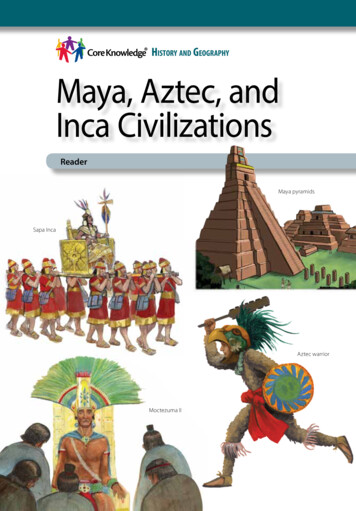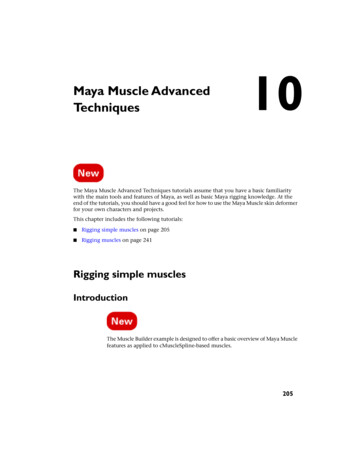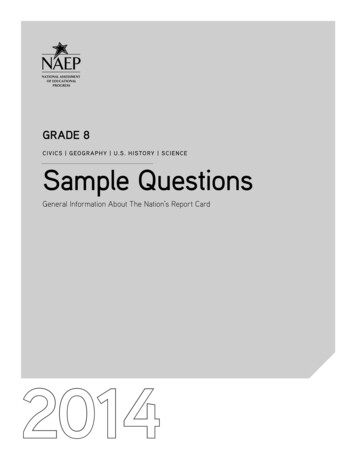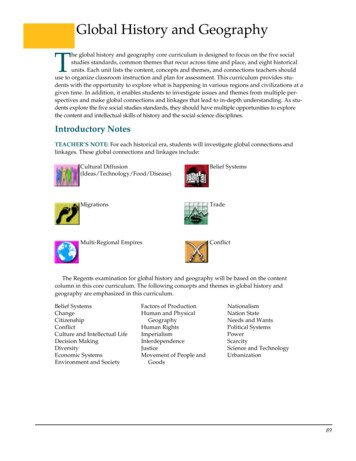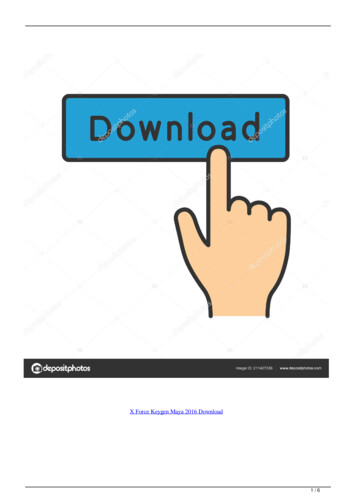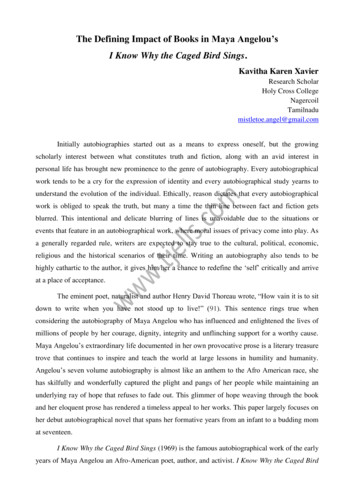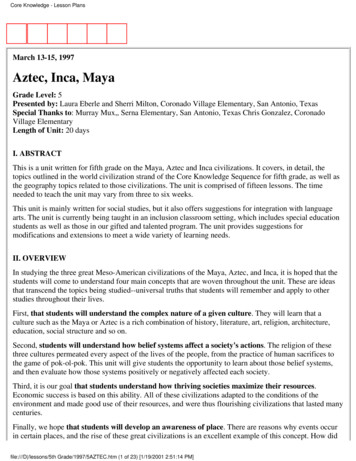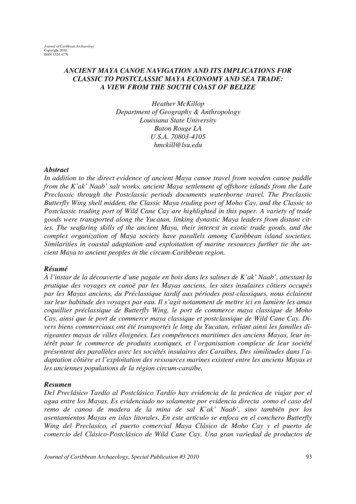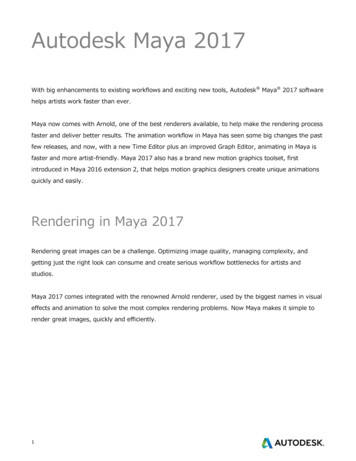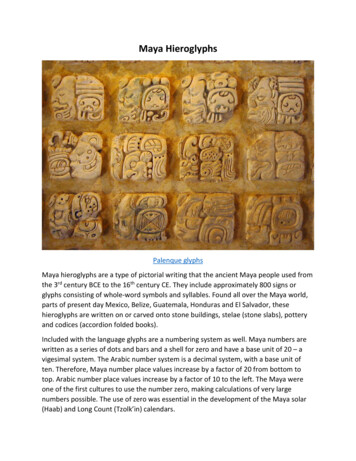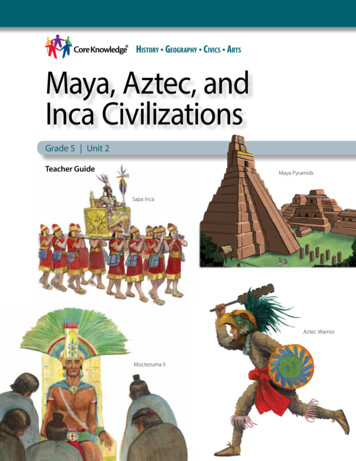
Transcription
History Geography Civics ArtsMaya, Aztec, andInca CivilizationsGrade 5 Unit 2Teacher GuideMaya PyramidsSapa IncaAztec WarriorMoctezuma II
Maya, Aztec,and IncaCivilizationsGrade 5 Unit 2Teacher Guide
Creative Commons LicensingThis work is licensed under aCreative Commons Attribution-NonCommercialShareAlike 4.0 International License.You are free:to Share—to copy, distribute, and transmit the workto Remix—to adapt the workUnder the following conditions:Attribution—You must attribute the work in thefollowing manner:This work is based on an original work of the CoreKnowledge Foundation made available throughlicensing under a Creative Commons AttributionNonCommercial-ShareAlike 4.0 International License.This does not in any way imply that the CoreKnowledge Foundation endorses this work.Noncommercial—You may not use this work forcommercial purposes.Share Alike—If you alter, transform, or build upon thiswork, you may distribute the resulting work only underthe same or similar license to this one.With the understanding that:For any reuse or distribution, you must make clear toothers the license terms of this work. The best way todo this is with a link to this web /4.0/All Rights Reserved.Core Knowledge andCore Knowledge Curriculum Series are trademarks of the Core Knowledge Foundation.Trademarks and trade names are shown in this bookstrictly for illustrative and educational purposes andare the property of their respective owners. Referencesherein should not be regarded as affecting the validity ofsaid trademarks and trade names.ISBN: 978-1-68380-027-9Copyright 2016 Core Knowledge Foundationwww.coreknowledge.org
Maya, Aztec,and IncaCivilizationsTable of ContentsIntroduction . . . . . . . . . . . . . . . . . . . . . . . . . . . . . . . . . . . . . . . . . . . . . . . . . . . . . . . 1Maya, Aztec, and Inca Civilizations Sample Pacing Guide . . . . . . . . . . . . . . . . . . . 14Chapter 1The Maya: Rainforest Civilization. . . . . . . . . . . . . 16Chapter 2Maya Science and Daily Life. . . . . . . . . . . . . . . . . . . . 30Chapter 3The Aztec: Empire Builders. . . . . . . . . . . . . . . . . . . . . 38Chapter 4Tenochtitlán: City of Wonder . . . . . . . . . . . . . . . . . . 45Chapter 5The Inca: Lords of the Mountains . . . . . . . . . . . . . 52Chapter 6Inca Engineering . . . . . . . . . . . . . . . . . . . . . . . . . . . . . . . . . 59Chapter 7The End of Two Empires . . . . . . . . . . . . . . . . . . . . . . . . 67Teacher Resources . . . . . . . . . . . . . . . . . . . . . . . . . . . . . . . . . . . . . . . . . . . . . . . . . . 77
UNIT 2IntroductionAbout this UnitThe Big IdeaThe Maya, Aztec, and Inca had developed large, complex civilizations prior to the arrival ofthe Spanish.The civilizations of the Maya, Aztec, and Inca that once flourished in Centraland South America shared common elements. People practiced farming,developed social structures, raised armies, and worshipped many gods.The three civilizations were as diverse as the terrains in which they lived.The Maya, known for developing a system of mathematics, thrived in therainforests of the Yucatán Peninsula, Belize, Honduras, and Guatemala fromabout 200 to 900 CE. From 1325 to 1521, the Aztec built a large and dense cityat Tenochtitlán, located on a swampy lake in the middle of a semi-arid basinin central Mexico. The Inca were skilled engineers who built a vast system ofroads and bridges to unite their empire located high in the Andes Mountains,reaching their peak in the 1400s and early 1500s.It remains in question why and how the rainforest cities of the Classic Maya fell.We know that Spanish explorers precipitated the destruction of both the Aztecand Inca empires.INTRODUCTION1
What Students Should Already KnowStudents in Core Knowledge schools should be familiar with:Kindergarten The voyage of Columbus in 1492-- Queen Isabella and King Ferdinand of Spain-- The Niña, Pinta, and Santa Maria-- Columbus’s mistaken identification of “Indies” and “Indians”-- The idea of what was, for Europeans, a “New World”Grade 1 Maya, Aztec, and Inca Civilizations-- The development by the Maya of large population centers in therainforests of Mexico and Central America-- The establishment of a vast empire in central Mexico by the Aztec, itscapital of Tenochtitlán, and its emperor Moctezuma (Montezuma)-- The Inca’s establishment of a far-ranging empire in the AndesMountains of Peru and Chile, including Machu Picchu Columbus The conquistadors-- The search for gold and silver Hernán Cortés and the Aztec Francisco Pizarro and the Inca Diseases devastate Native American populationGrade 2 The geography of South America-- Brazil: largest country in South America, Amazon River, rainforests-- Peru and Chile: Andes Mountains-- Locate: Venezuela, Colombia, Ecuador-- Bolivia: named after Simón Bolívar, “The Liberator”-- Argentina: the Pampa (also known as the Pampas)-- Main languages: Spanish and (in Brazil) Portuguese2GRADE 5 UNIT 2 MAYA, AZTEC, AND INCA CIVILIZATIONS
Time Period BackgroundThe items below refer to content in Grade 5.Use a classroom timeline with students tohelp them sequence and relate events fromdifferent periods and groups.c. 1500 BCEEarliest Mesoamerican villagesWhat Students Need to Learn Identify and locate Central America and South America on mapsand globes-- Largest countries in South America: Brazil and ArgentinaPeak of Maya civilization Amazon Riverc. 1300sBeginning of Aztec Empire Andes Mountainsc. 1300sBeginning of Inca Empirec. 200–900 CE1400s149214961500s1513First cargo of enslaved peoplefrom Africa brought byPortuguese to their coloniesColumbus’s first voyage tothe AmericasSanto Domingo onHispaniola founded asfirst permanent Spanishsettlement in AmericasSpanish brought the firstcargo of enslaved Africansto HispaniolaBalboa “discovers” thePacific Ocean1517Luther initiates ProtestantReformation1517Ponce de León lands in Florida The Maya-- Ancient Maya lived in what is now southern Mexico and parts ofCentral America; their descendants still live there today-- Accomplishments as architects and artisans: pyramids and temples-- Development of a system of hieroglyphic writing-- Knowledge of astronomy and mathematics; use of a 365-daycalendar; early use of the concept of zero The Aztec-- At its height in the 1400s and early 1500s, the Aztecempire covered much of what is now central Mexico-- The island city of Tenochtitlán: aqueducts, massive temples, etc.-- Moctezuma (also spelled Montezuma)-- Ruler-priests; practice of human sacrifice The Inca-- Ruled an empire stretching along the Pacific Coast of South America1519–21Magellan circumnavigatesthe globe1521Conquest of the Aztec byCortés1534Conquest of the Inca byPizarro1534Cartier of France exploresthe St. Lawrence River1535Most of central Mexico inSpanish hands-- Built great cities (Machu Picchu, Cuzco) high in the Andes, connectedby a system of roads Conquistadors: Cortés and Pizarro-- Advantages of Spanish weaponry (guns and cannons)-- Devastation of native peoples by European diseases1539–4215401545–65c. 1570INTRODUCTIONDe Soto exploresNorth AmericaMost of Peru under SpanishcontrolMajor silver discoveries inMexico and PeruEnd of era of conquistadors3
At a GlanceThe most important ideas in Unit 2 are: Students should be able to locate Mexico, Central America, South America,and the major countries, rivers, and mountain chain in South America onmaps and globes. Mesoamerica is a cultural area that covers central and southern Mexico aswell as northern Central America. The Maya people constructed large monumental buildings, created ahieroglyphic writing system, employed a 365-day calendar, and developedthe concept of zero. The Aztec dominated central and southern Mexico through force and atribute system. The Inca developed a widespread empire in the Andes Mountains linked bya network of roads. Both the Aztec and the Inca empires were conquered by Spanishconquistadors; the Aztec Empire was conquered by Cortés, and the IncaEmpire was defeated by Pizarro. The Spanish had an advantage over native peoples because the former hadguns, cannons, and horses. European diseases killed thousands of native peoples, who had no naturalimmunity against them.What Teachers Need to KnowGeography Related to Central and South AmericaCentral America is part of North America and contains the countries of Belize,Costa Rica, El Salvador, Guatemala, Honduras, Nicaragua, and Panama. It isbordered by the Caribbean Sea to the east and by the Pacific Ocean to thewest. To the south is the continent of South America. Central America is anisthmus, or land bridge, that connects the two larger bodies of land.South America is the fourth largest continent. To the east is the AtlanticOcean, and to the west, the Pacific Ocean. The Caribbean Sea borders SouthAmerica to the north. The Andes Mountains range from north to south onthe far western side of South America. The northern portion of the continent,including much of Brazil, is covered by tropical rainforest.BrazilBrazil covers almost half of the South American continent and is the fifthlargest country in the world. Brazil is so large that it borders all but two (Chile4GRADE 5 UNIT 2 MAYA, AZTEC, AND INCA CIVILIZATIONS
and Ecuador) of the other twelve countries in South America. The word Brazilcomes from the name of a tree found in the Amazon rainforest. Brazil liesmostly within the tropical zone, so its climate is mainly warm and wet.Most of the people live in urban areas, and about thirty percent of thepopulation lives on the coastal plain, a narrow strip along the Atlantic Ocean.About seven hundred thousand native people live within the rainforest, butmany others live in cities and urban areas. The overall population is a mix ofdescendants of Portuguese, native peoples, and Africans. Brazil was conqueredby Portugal, unlike most of South America, which was conquered by theSpanish. Its official language is Portuguese.ArgentinaArgentina is the second largest country in South America. A long, narrowcountry, Argentina extends east and south of the Andes and south of Paraguayand Uruguay. The Andes form the boundary between Argentina and Chile.The Gran Chaco, a region of low forests and grasslands, dominates Argentina’snorthern region. The south is a collection of barren plateaus, known asPatagonia. The major economic area of Argentina is the Pampa (also knownas the Pampas) in the center of the country. This region of tall grasslands andtemperate climate is famous for its cattle ranches. About seventy percent ofthe population lives in this area.Most Argentines are descendants of Spanish colonists, and Spanish is theofficial language.Amazon RiverThe Amazon River forms at the junction of the Ucayali (/ooh*cah*yah*lee/) andMarañón (/marn*yeown/) Rivers in northern Peru and empties into the AtlanticOcean through a delta in northern Brazil. The Amazon is the second longestriver in the world after the Nile but has the largest volume of water of anyriver in the world. Hundreds of tributaries feed into it. The Amazon River basindrains more than forty percent of South America. With no waterfalls, the river isnavigable for almost its entire length.The Amazon flows through the world’s largest rainforest. This rainforest ishome to more than 2.5 million species of insects, tens of thousands of plants,and over one thousand species of birds. In fact, almost half of all of theworld’s known species can be found in the Amazon. Mammals in the Amazonrainforests include the tapir (a hoofed mammal), the nutria (an otter-likecreature), the great anteater, and various kinds of monkeys. Insects includelarge, colorful butterflies. Birds include hummingbirds, toucans, and parrots. Afamous reptile dweller is the anaconda, a huge snake that squeezes its victimsto death; alligators are also common. Fish include flesh-eating piranhas andthe electric eel, capable of discharging a shock up to 650 volts. In recent years,environmentalists have grown concerned about threats to the ecosystemposed by logging and deforestation in this rainforest.INTRODUCTION5
The Amazon was named by a Spanish explorer, Francisco de Orellana, whoexplored the river in 1541 and named it after women warriors he encounteredwho reminded him of descriptions of the Amazons in ancient Greek mythology.Andes MountainsThe Andes Mountains are over five thousand miles (8,047 km) in length, thelongest mountain system in the Western Hemisphere. The mountains begin asfour ranges in the Caribbean area on the northeastern coast of South America.In Peru and Bolivia, the mountains form two parallel ranges that create a wideplateau known as the Altiplano. The Andes then form a single range thatseparates Chile from Argentina.With an average height of 12,500 feet (3,810 m), the Andes are the secondhighest mountain range in the world. (The Himalayas are the highest.) Thetallest peak in the Western Hemisphere is the Andes’s Mount Aconcagua,which rises 22,835 feet (6,960 m) above sea level. Many of the mountains arevolcanoes, either active or dormant.Approximately fifty to sixty percent of Peru’s people live in the Altiplano. Abouta third of the country’s population lives in the narrow lowlands between theAndes and the Pacific Ocean. Because the Andes run north to south along theentire length of Chile, most Chileans live in the Central Valley region betweenthe Andes and low coastal mountains. The Central Valley, a fertile area, is hometo large cities, manufacturing centers, and agriculture.The Andes Mountains were the home of the Inca people, whom studentsin Core Knowledge schools studied in Grade 1 and will study again as partof this unit. Core Knowledge students should also have learned aboutMount Aconcagua and the Andes during the Grade 4 geography subsection“Mountains and Mountain Ranges.”Historical BackgroundStudents who studied the Core Knowledge curriculum in Grade 1 learnedabout how civilizations in the Americas grew. The Maya civilization was locatedin the Yucatán Peninsula and covered parts of Mexico, Belize, Honduras,and Guatemala. Maya cities were built with large centers that includedlarge temples and often ball courts. Houses did not exist in the city centers,indicating that they were meant for religious purposes. It’s important to notethat first-grade students were not exposed to the concept of human sacrificeas a part of both Maya and Aztec religions that will be discussed in this unit.Most Maya earned a living as farmers. Priests acted as the ruling class. TheMaya civilization disappeared around the year 900 CE; some of their citieswere in ruins by the time Spanish arrived in the 1600s.The Aztec, also referred to as the Mexica, began as a group of nomadicpeoples who settled on Lake Texcoco in central Mexico around the year 1325.Tenochtitlán, the Aztec capital, was the home to as many as three hundredthousand people at the time of Spanish arrival. Students learned that the Aztec6GRADE 5 UNIT 2 MAYA, AZTEC, AND INCA CIVILIZATIONS
built a vast empire through conquest. They did not directly rule but reliedon a tribute system to expand their wealth. Aztec rulers were seen as divine,part man and part god. Moctezuma II was ruler of the Aztec when Cortés firstexplored Mexico.The Inca, like the Aztec, built an empire through conquest. From about 1438to 1525, the Inca ruled an empire that stretched from Ecuador through partsof Peru, Chile, Bolivia, and Argentina. Students learned that the Inca built anadvanced system of roads to maintain their empire. Roads, bridges, and otherinfrastructure made it easier to travel and communicate to administer a vastempire. Runners called chasquis carried messages throughout the Inca world.To learn more background information about specific topics taught in Maya,Aztec, and Inca Civilizations, go to www.coreknowledge.org/about-mayaaztec-inca.Unit ResourcesStudent ComponentThe Maya, Aztec, and Inca Civilizations Student Reader—seven chaptersTeacher ComponentsThe Maya, Aztec, and Inca Civilizations Teacher Guide—seven chapters.This includes lessons aligned to each chapter of the Maya, Aztec, and IncaCivilizations Student Reader with a daily Check For Understanding andAdditional Activities, such as virtual field trips and cross-curricular art activities,designed to reinforce the chapter content. A Unit Assessment, PerformanceTask Assessment, Activity Pages, and Nonfiction Excerpts of primary sourcedocuments are included at the end of this Teacher Guide in Teacher Resources,beginning on page 77.»» The Unit Assessment tests knowledge of the entire unit, usingstandard testing formats.»» The Performance Task Assessment requires students to apply andshare the knowledge learned during the unit through either an oral orwritten presentation.»» The Activity Pages are designed to reinforce and extend contenttaught in specific chapters throughout the unit. These optionalactivities are intended to provide choices for teachers.Maya, Aztec, and Inca Civilizations Timeline Image Cards include nine individualimages depicting significant events and individuals from the time when theMaya, Aztec, and Inca civilizations flourished. In addition to an image, eachINTRODUCTION7
card contains a caption, a chapter number, and the Big Question, whichoutlines the focus of the chapter. You will construct a classroom Timeline withstudents over the course of the entire unit. The Teacher Guide will prompt you,lesson by lesson, as to which image card(s) to add to the Timeline. The Timelinewill be a powerful learning tool enabling you and your students to trackimportant themes and events as they occurred within this time period.TimelineSome advance preparation will be necessary prior to starting Unit 2.You will need to identify available wall space in your classroom ofapproximately 10 feet on which you can post the Timeline ImageCards over the course of the unit. The Timeline may be oriented eithervertically or horizontally, even wrapping around corners and multiplewalls, whatever works best in your classroom setting. Be creative—someteachers hang a clothesline so that the image cards can be attached withclothespins!Create five time indicators or reference points for the Timeline. Write eachof the following dates on sentence strips or large index cards: 1500 BCE 200 CE 1300s 1400s 1500sAffix these time indicators to your wall space, allowing sufficient spacebetween them to accommodate the actual number of image cards you will beadding to each time period, as per the following diagram.Chapter81500 BCE200 CE1300s1400s1500s 123, 577GRADE 5 UNIT 2 MAYA, AZTEC, AND INCA CIVILIZATIONS
You will want to post all the time indicators on the wall at the outset beforeyou place any image cards on the timeline.1500 BCE200 CEChapter 1Chapter 21300sChapter 31300s1400sChapter 5Chapter 71500sChapter 71500s1500sChapter 7Chapter 71500sChapter 7The Timeline in Relation to the Content in the Student Reader ChaptersYou will see that the events highlighted in the Unit 2 Timeline are inchronological (date) order. The unit as a whole deals with large, thematicconcepts that are reflected in the Timeline.Understanding References to Time in the Maya, Aztec, and Inca Civilizations UnitAs you read the text, you will become aware that in some instances generaltime periods are referenced and that in other instances specific dates are cited.For example, Chapter 1 states that the Maya civilization thrived over a periodof many centuries—200 CE to 900 CE. In addition, certain events are onlyINTRODUCTION9
generally fixed in time—for example, that the Inca Empire gained strength inthe 1400s. In contrast, there are many references to specific dates in history.Here are just a few:The Aztec founded their capital city by 1325.Hernán Cortés launched his final attack on Tenochtitlán in 1521.Pizarro began his quest to find the Inca Empire in 1527.Because of this, it is important to explain to students that some chapters dealwith themes that were important throughout the entire era of civilizationbuilding in the Americas. It is also important to note that our knowledge ofthese times is inhibited by our limited understanding of or access to the recordkeeping of these great civilizations. It is sometimes difficult to know preciselywhen certain events took place. In some cases, however, the chapters deal withimportant people and particular events that occur in specific moments in time.In these instances, we do have specific knowledge and records. Therefore,these chapters tend to contain specific dates for key events in history. Inaddition, when citing specific dates, the abbreviation CE is used. It’s importantthat students understand that the abbreviation CE is used to denote “CommonEra.” (BCE—before the Common Era—is also used here and in other units inthis program.) Students may have encountered CE before, or they may be morefamiliar with the traditional abbreviations AD and BC. Both CE and AD referto the time period from the time of Jesus Christ. BCE and BC refer to the timeperiod before Christ.Time to Talk About TimeBefore you use the Timeline, discuss with students the concept of time and howit is recorded. Here are several discussion points that you might use to promotediscussion. This discussion will allow students to explore the concept of time.1. What is time?2. How do we measure time?3. How do we record time?4. How does nature show the passing of time? (Encourage students to thinkabout days, months, and seasons.)5. What is a specific date?6. What is a time period?7. What is the difference between a specific date and a time period?8. What does CE mean?9. What is a timeline?10GRADE 5 UNIT 2 MAYA, AZTEC, AND INCA CIVILIZATIONS
Using the Teacher GuidePacing GuideThe Maya, Aztec, and Inca Civilizations unit is one of thirteen history andgeography units in the Grade 5 Core Knowledge Curriculum Series . A total often days have been allocated to the Maya, Aztec, Inca unit. We recommend thatyou do not exceed this number of instructional days to ensure that you havesufficient instructional time to complete all Grade 5 units.At the end of this Introduction, you will find a Sample Pacing Guide that providesguidance as to how you might select and use the various resources in this unitduring the allotted time. However, there are many options and ways that you maychoose to individualize this unit for your students, based on their interests andneeds. So we have also provided you with a blank Pacing Guide that you mayuse to reflect the activity choices and pacing for your class. If you plan to create acustomized pacing guide for your class, we strongly recommend that you previewthis entire unit and create your pacing guide before teaching the first chapter.Reading AloudIn each chapter, the teacher or a student volunteer will read various sections ofthe text aloud. When you or a student reads aloud, always prompt students tofollow along. By following along in this way, students become more focused onthe text and may acquire a greater understanding of the content.Turn and TalkIn the Guided Reading Supports section of each chapter, provide studentswith opportunities to discuss the questions in pairs or in groups. Discussionopportunities will allow students to more fully engage with the content andwill bring “to life” the themes or topics being discussed.Big QuestionsAt the beginning of each Teacher Guide chapter, you will find a Big Question,also found at the beginning of each Student Reader chapter. The Big Questionsare provided to help establish the bigger concepts and to provide a generaloverview of the chapter. The Big Questions, by chapter, are:INTRODUCTIONChapterBig Question1What do the ruins of the Maya tell you about the importance ofreligion to their civilization?2Why is the 365-day solar calendar developed by the Mayaparticularly impressive?11
3Why did the Aztec make human sacrifices?4What does the description of Tenochtitlán reveal about the Azteccivilization?5Why were llamas so important to the Inca?6How did the Inca use their engineering skills to manage and growtheir empire?7What were the factors that contributed to the end of the Aztecand Inca empires?Core VocabularyDomain-specific vocabulary, phrases, and idioms highlighted in each chapter ofthe Student Reader are listed at the beginning of each Teacher Guide chapter,in the order in which they appear in the Student Reader. Student Reader pagenumbers are also provided. The vocabulary, by chapter, are:ChapterVocabulary1Mesoamerica, Maya, civilization, architecture, archaeologist,city-state, temple, hieroglyph, sacrifice2astronomy, leap year, equinox, “initiation ceremony,” priest3Aztec, nomadic, empire, emperor4causeway, canal, scribe, codex, pictogram, litter, reign5Inca, conquistador, “geographical diversity,” plateau, clan, alpaca,llama, census6official, engineer, mortar, suspension bridge, terrace7expedition, “religious ceremony,” smallpox, immunity, epidemicActivity PagesThe following activity pages can be found in Teacher Resources, pages 88 to 100.They are to be used with the chapter specified either for additional class workor for homework. Be sure to make sufficient copies for your students prior toconducting activities.12 Chapter 1—World Map (AP 1.1) Chapter 1—World Geography (AP 1.2) Chapter 1— Modern Map of North America, Central America, and SouthAmerica (AP 1.3) Chapter 1—Geography of the Americas (AP 1.4) Chapter 1—Map of the Maya, Aztec, and Inca Civilizations (AP 1.5) Chapter 1—Geography of the Maya, Aztec, and Inca Civilizations (AP 1.6)GRADE 5 UNIT 2 MAYA, AZTEC, AND INCA CIVILIZATIONS
Chapters 2, 4, 6—Summary of the Maya, Aztec, and Inca Civilizations (AP 2.1) Chapter 4—Domain Vocabulary: Chapters 1–4 (AP 4.1) Chapter 4—Create a Codex (AP 4.2) Chapter 7—Domain Vocabulary: Chapters 5–7 (AP 7.1)Nonfiction ExcerptsTwo nonfiction excerpts can be found in Teacher Resources, pages 101 to 105.They may be used with the chapter specified either for additional class work orat the end of the unit as review and/or a culminating activity. Be sure to makesufficient copies for your students prior to conducting the activities.Nonfiction ExcerptsChapter 7—Primary Source Document: Cortés’s Second Letter to Charles V (NFE 1)Chapter 7—History of the Conquest of Peru (excerpts from the book by WilliamHickling Prescott) (NFE 2)Additional ActivitiesAn Additional Activities section, related to material in the Student Reader, maybe found at the end of each chapter. You may choose from among the variedactivities when conducting lessons. Many of the activities include website links,and you should check the links prior to using them in class.BooksHaberstroh, Marilyn & Panik, Sharon. A Quetzalcoatl Tale of Chocolate.CO: University Press of Colorado, 2014.DK Publishing. Aztec, Inca, & Maya. New York: DK Children, 2011.Newman, Sandra. The Inca Empire (True Books: Ancient Civilizations). New York:Scholastic, 2010.Mathews, Sally Schofer. The Sad Night: The Story of an Aztec Victory and a SpanishLoss. Boston: HMH Books for Young Readers, 2001Maloy, Jackie. The Ancient Maya (True Books). Danbury, CT: Children’s Press, 2010INTRODUCTION13
Maya, Aztec, and Inca Civilizations Sample Pacing GuideFor schools using the Core Knowledge Sequence and/or CKLATG – Teacher Guide; SR – Student Reader; AP – Activity Page;NFE – Nonfiction ExcerptWeek 1Day 1Day 2Day 3Day 4Day 5“The Maya:RainforestCivilization”(TG & SR, Chapter 1)“Maya Science and DailyLife”Core Lesson(TG & SR, Chapter 2)“Summary of theMaya, Aztec, and IncaCivilizations”(TG, Chapter 2, AdditionalActivities, AP 2.1)“The Aztec: EmpireBuilders”Core Lesson(TG & SR, Chapter 3)“Personal Narratives”“Personal Narratives”“Personal Narratives”“Personal Narratives”Day 7Day 8Day 9Day 10“The Inca: Lords of theMountains”Core Lesson(TG & SR, Chapter 5)Homework: “DomainVocabulary: Chapters 1–4,”AP 4.1)“Inca Engineering”Core Lesson(TG & SR, Chapter 6)Homework: “Summaryof the Maya, Aztec,and Inca Civilizations”(TG, Chapter 6, AdditionalActivities, AP 2.1)“The End of Two Empires”Core Lesson(TG & SR, Chapter 7)Homework: “DomainVocabulary: Chapters 5–7,”AP 7.1)Unit Assessment(TG)“Personal Narratives”“Personal Narratives”“Personal Narratives”“Personal Narratives”Maya, Aztec, and Inca Civilizations“World Map,” “ModernMap of North America,Central America, andSouth America,” and “Mapand Geography of theMaya, Aztec, and IncaCivilizations”(TG, Chapter 1, AdditionalActivities, AP 1.1, 1.3, 1.5,and 1.6)Homework: “WorldGeography,” AP 1.2 and“Geography of NorthAmerica, Central America,and South America,” AP 1.4CKLA“Personal Narratives”Week 2Day 6Maya, Aztec, and Inca Civilizations“Tenochtitlán: City ofWonder”Core Lesson(TG & SR, Chapter 4)Homework: “Summaryof the Maya, Aztec,and Inca Civilizations”(TG, Chapter 4, AdditionalActivities, AP 2.1)CKLA“Personal Narratives”14GRADE 5 UNIT 2 MAYA, AZTEC, AND INCA CIVILIZATIONS
Maya, Aztec, and Inca Civilizations Pacing Guide‘s Class(A total of ten days have been allocated to the Maya, Aztec, and Inca Civilizations unit in order tocomplete all Grade 5 history and geography units in the Core Knowledge Curriculum Series .)Week 1Day 1Day 2Day 3Day 4Day 5Day 8Day 9Day 10Maya, Aztec, and Inca CivilizationsCKLAWeek 2Day 6Day 7Maya, Aztec, and Inca CivilizationsCKLAINTRODUCTION15
CHAPTER 1The Maya:Rainforest CivilizationThe Big Question: What do the ruins of the Maya tell you about the importance ofreligion to their civilization?Primary Focus Objectives Identify the Maya as one of the earliest civilizations in the Americas, located in parts of Mexico andCentral America. (RI.5.2) Describe how a
Spanish hands 1539-42 De Soto explores North America 1540 Most of Peru under Spanish control 1545-65 Major silver discoveries in Mexico and Peru c. 1570 End of era of conquistadors What Students Need to Learn Identify and locate Central America and South America on maps and globes - Largest countries in South America: Brazil and Argentina
